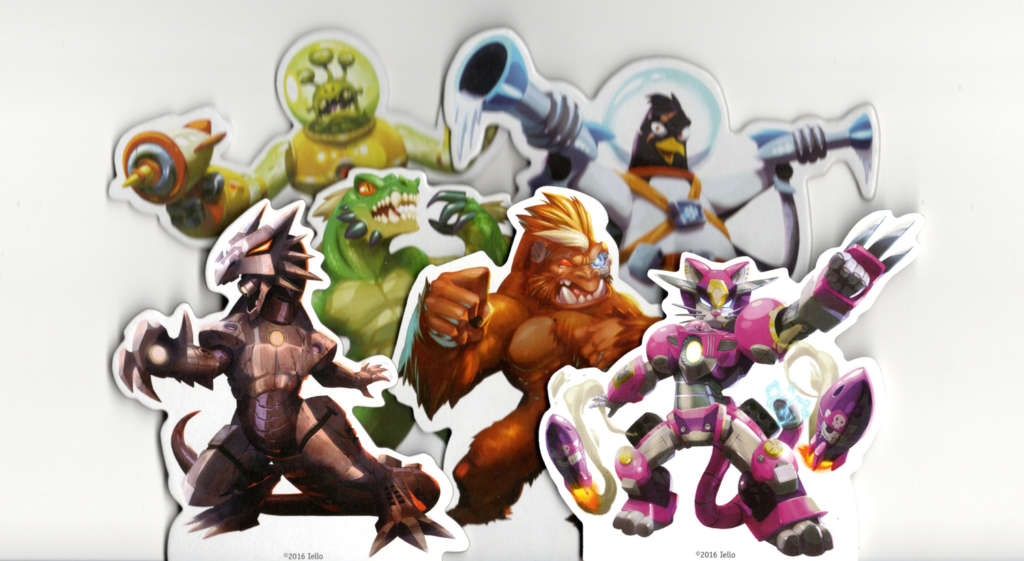In the board game King of Tokyo, players play as monsters trying to take control of Tokyo. In order to take control of Tokyo players must roll six dice to earn resources whether that be victory points, claws that deal damage, health that heals, or lightning bolts that grant energy. Additionally, players have cardboard cutout standees of their monster and can choose whether to place their monster in Tokyo or to keep the monster out, there are only two spots in Tokyo and monsters outside of Tokyo deal damage to monsters in Tokyo and vice versa. The game is played until a few win conditions are met either all the other players have lost their health so one monster remains standing or a player earns 20 victory points. Therefore, there is both a passive way to win the game through gaining points by getting lucky with your rolls or a more aggressive way by depleting the health of your opponents that all players must juggle with their dice rolls.
The game mechanic that stood out to me the most was probably the dice rolling mechanic. In King of Tokyo, you can roll dice up to three times. With each roll you pick out which dice you want to keep and players can then reroll the dice two more times each time selectively keeping the dice they want to. This is not a particularly new mechanic to me as the first thing I thought when I saw it was, “Oh this is just like the rolling in the Genshin Impact TCG!” (yes I am exposing myself as a Genshin Impact player). However, the Genshin Impact TCG differs in that only one reroll is allowed after choosing which dice to keep. I personally feel that being able to roll dice a total of three times is a bit too much and actually made the game a rather unfun experience for me as a meta started developing with the group I played with where we would keep the threes and just roll to get as many threes as possible. Therefore, the player who won was whoever had gotten lucky enough to roll multiple threes on their first roll so they would have a high chance to increase the number of threes and keep doing this until they got 20 victory points. Admittedly, I think this strategy could have been countered by other players attacking the player, but oftentimes the player getting all the victory points was outside of Tokyo and therefore could heal and also only take damage from whoever was in Tokyo. Additionally, the energy cards we saw were not enticing enough to waste rolls on getting energy and most of us just opted to roll for victory points instead of roll for damage as we all started with a lot of health, to begin with. I felt this sort of allowed the player too much tailoring of their rolls and removed some of the chance or gamble that should be there when you roll dice. I feel that limiting the reroll to just one or having players start with less health so player damage would be more of a threat would be some interesting changes to look into. Although, these mechanics would all need to be balanced as too low health means the game goes too fast, and limiting rerolls could cause the game to drag on longer just due to rng. Overall though my main critique of the game is that I personally did not enjoy the amount of rerolls and felt it limited the variety of playstyles one could have in the game, but I guess this also depends on whether the players are playing to win the quickest and most efficient way possible or playing to just curate an emergent narrative of monsters fighting in Tokyo with unique strategies and accruing different powerups.
Other than that there were some aspects of the game I did find to be successful or interesting. I thought the monster designs were fitting for the cartoony feel of the premise of monsters taking over a city evokes. The monsters felt like the type of monsters I would see in a cartoon that the heroes would have to fight. All of the characters look sort of plastic and feel like action figures further contributing to the toy/cartoon feel of the game. Having the characters be portrayed as cardboard cutouts made them feel like they sort of popped out or were distinct compared to your average board game piece.
While I think the game’s visual aspect was effective, I feel that the balancing of all the mechanics from the power-up cards to the dice-rolling would be adjusted as to me it was apparent that the power budget of certain mechanics could be exploited. I think the game certainly has potential, however, for me the game that should be about collecting a variety of resources to conquer a city felt more like a game purely based on who could roll the most victory points each turn.
